Application of AI in Predicting Hardness of Different Steel Grades
VerifiedAdded on 2022/10/06
|6
|1439
|395
Project
AI Summary
This project, conducted as part of a research methodology unit at Deakin University, focuses on applying Artificial Intelligence (AI) and Support Vector Machine (SVM) to predict the hardness of different heat-treated steel grades. The research involved experimental hardness tests on EN19 and EN24 steel alloys, followed by the development of an SVM model using MATLAB and kernel functions. The project aimed to accurately estimate hardness values under varied conditions and compare experimental results with SVM predictions, analyzing the effect of nickel on steel hardness. The findings indicated a strong correlation between experimental and predicted values, suggesting the SVM model's accuracy. The project demonstrates the potential of AI in engineering applications and offers insights into the challenges and methodologies of conducting research, contributing to a deeper understanding of steel properties and AI modeling.
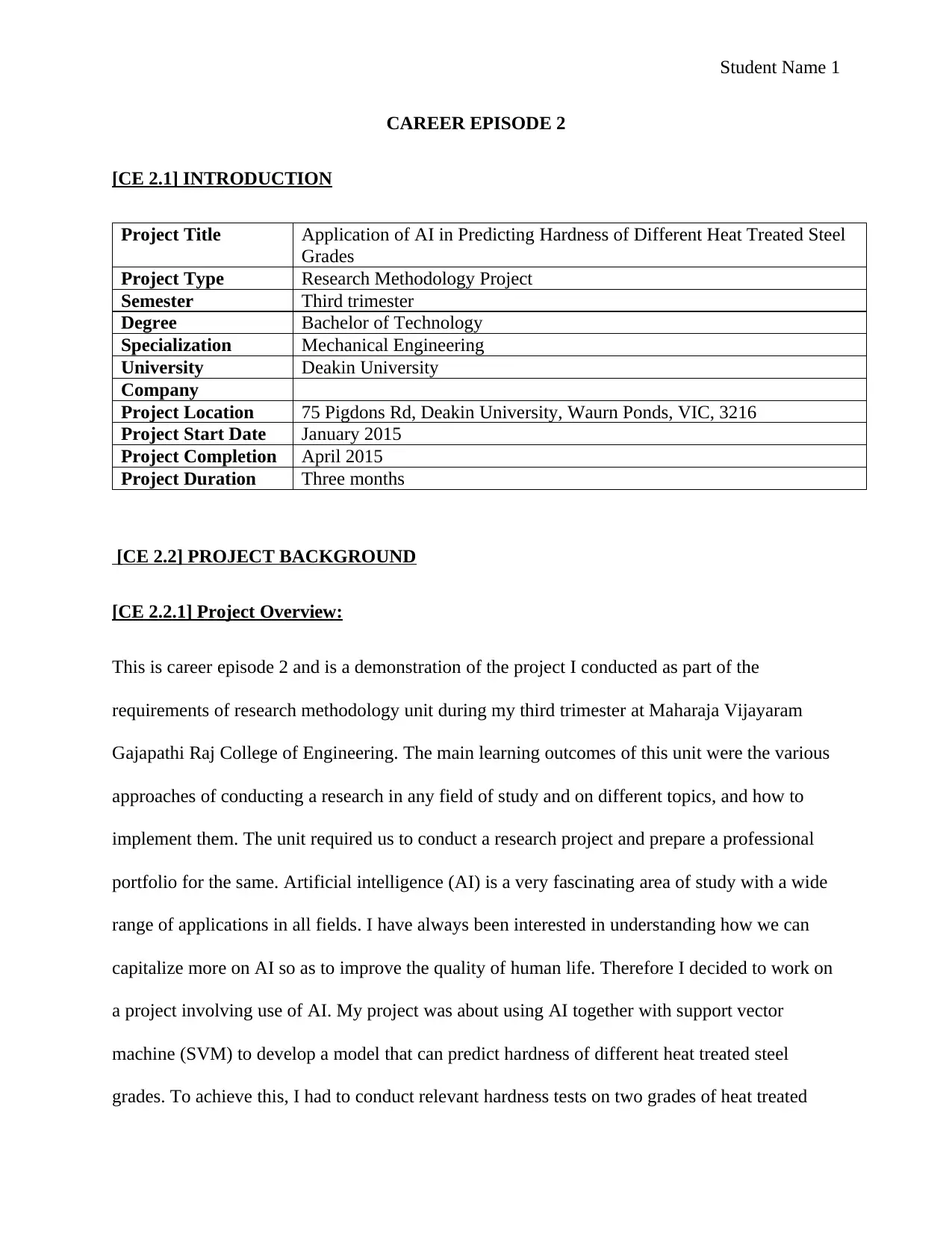
Student Name 1
CAREER EPISODE 2
[CE 2.1] INTRODUCTION
Project Title Application of AI in Predicting Hardness of Different Heat Treated Steel
Grades
Project Type Research Methodology Project
Semester Third trimester
Degree Bachelor of Technology
Specialization Mechanical Engineering
University Deakin University
Company
Project Location 75 Pigdons Rd, Deakin University, Waurn Ponds, VIC, 3216
Project Start Date January 2015
Project Completion April 2015
Project Duration Three months
[CE 2.2] PROJECT BACKGROUND
[CE 2.2.1] Project Overview:
This is career episode 2 and is a demonstration of the project I conducted as part of the
requirements of research methodology unit during my third trimester at Maharaja Vijayaram
Gajapathi Raj College of Engineering. The main learning outcomes of this unit were the various
approaches of conducting a research in any field of study and on different topics, and how to
implement them. The unit required us to conduct a research project and prepare a professional
portfolio for the same. Artificial intelligence (AI) is a very fascinating area of study with a wide
range of applications in all fields. I have always been interested in understanding how we can
capitalize more on AI so as to improve the quality of human life. Therefore I decided to work on
a project involving use of AI. My project was about using AI together with support vector
machine (SVM) to develop a model that can predict hardness of different heat treated steel
grades. To achieve this, I had to conduct relevant hardness tests on two grades of heat treated
CAREER EPISODE 2
[CE 2.1] INTRODUCTION
Project Title Application of AI in Predicting Hardness of Different Heat Treated Steel
Grades
Project Type Research Methodology Project
Semester Third trimester
Degree Bachelor of Technology
Specialization Mechanical Engineering
University Deakin University
Company
Project Location 75 Pigdons Rd, Deakin University, Waurn Ponds, VIC, 3216
Project Start Date January 2015
Project Completion April 2015
Project Duration Three months
[CE 2.2] PROJECT BACKGROUND
[CE 2.2.1] Project Overview:
This is career episode 2 and is a demonstration of the project I conducted as part of the
requirements of research methodology unit during my third trimester at Maharaja Vijayaram
Gajapathi Raj College of Engineering. The main learning outcomes of this unit were the various
approaches of conducting a research in any field of study and on different topics, and how to
implement them. The unit required us to conduct a research project and prepare a professional
portfolio for the same. Artificial intelligence (AI) is a very fascinating area of study with a wide
range of applications in all fields. I have always been interested in understanding how we can
capitalize more on AI so as to improve the quality of human life. Therefore I decided to work on
a project involving use of AI. My project was about using AI together with support vector
machine (SVM) to develop a model that can predict hardness of different heat treated steel
grades. To achieve this, I had to conduct relevant hardness tests on two grades of heat treated
Paraphrase This Document
Need a fresh take? Get an instant paraphrase of this document with our AI Paraphraser
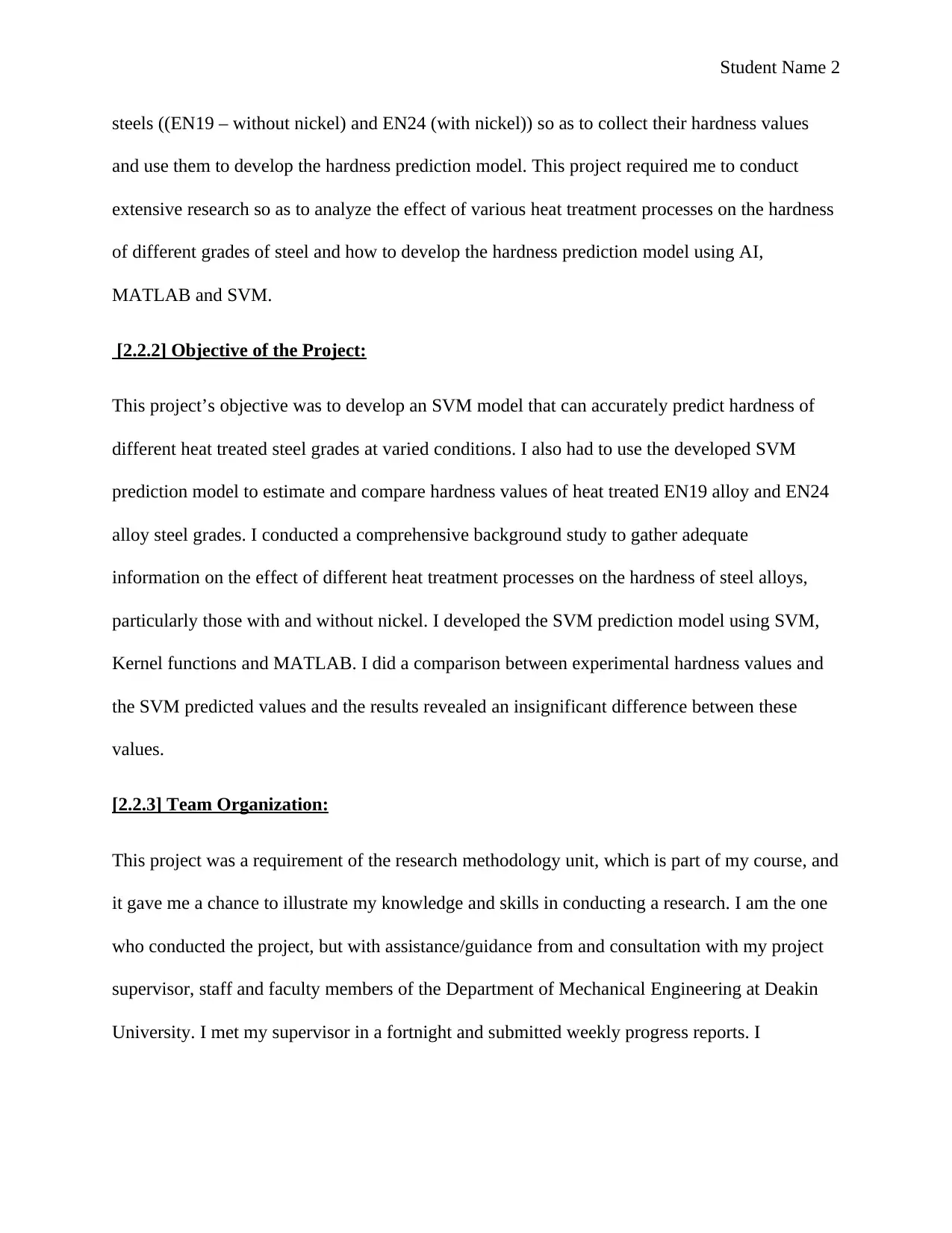
Student Name 2
steels ((EN19 – without nickel) and EN24 (with nickel)) so as to collect their hardness values
and use them to develop the hardness prediction model. This project required me to conduct
extensive research so as to analyze the effect of various heat treatment processes on the hardness
of different grades of steel and how to develop the hardness prediction model using AI,
MATLAB and SVM.
[2.2.2] Objective of the Project:
This project’s objective was to develop an SVM model that can accurately predict hardness of
different heat treated steel grades at varied conditions. I also had to use the developed SVM
prediction model to estimate and compare hardness values of heat treated EN19 alloy and EN24
alloy steel grades. I conducted a comprehensive background study to gather adequate
information on the effect of different heat treatment processes on the hardness of steel alloys,
particularly those with and without nickel. I developed the SVM prediction model using SVM,
Kernel functions and MATLAB. I did a comparison between experimental hardness values and
the SVM predicted values and the results revealed an insignificant difference between these
values.
[2.2.3] Team Organization:
This project was a requirement of the research methodology unit, which is part of my course, and
it gave me a chance to illustrate my knowledge and skills in conducting a research. I am the one
who conducted the project, but with assistance/guidance from and consultation with my project
supervisor, staff and faculty members of the Department of Mechanical Engineering at Deakin
University. I met my supervisor in a fortnight and submitted weekly progress reports. I
steels ((EN19 – without nickel) and EN24 (with nickel)) so as to collect their hardness values
and use them to develop the hardness prediction model. This project required me to conduct
extensive research so as to analyze the effect of various heat treatment processes on the hardness
of different grades of steel and how to develop the hardness prediction model using AI,
MATLAB and SVM.
[2.2.2] Objective of the Project:
This project’s objective was to develop an SVM model that can accurately predict hardness of
different heat treated steel grades at varied conditions. I also had to use the developed SVM
prediction model to estimate and compare hardness values of heat treated EN19 alloy and EN24
alloy steel grades. I conducted a comprehensive background study to gather adequate
information on the effect of different heat treatment processes on the hardness of steel alloys,
particularly those with and without nickel. I developed the SVM prediction model using SVM,
Kernel functions and MATLAB. I did a comparison between experimental hardness values and
the SVM predicted values and the results revealed an insignificant difference between these
values.
[2.2.3] Team Organization:
This project was a requirement of the research methodology unit, which is part of my course, and
it gave me a chance to illustrate my knowledge and skills in conducting a research. I am the one
who conducted the project, but with assistance/guidance from and consultation with my project
supervisor, staff and faculty members of the Department of Mechanical Engineering at Deakin
University. I met my supervisor in a fortnight and submitted weekly progress reports. I
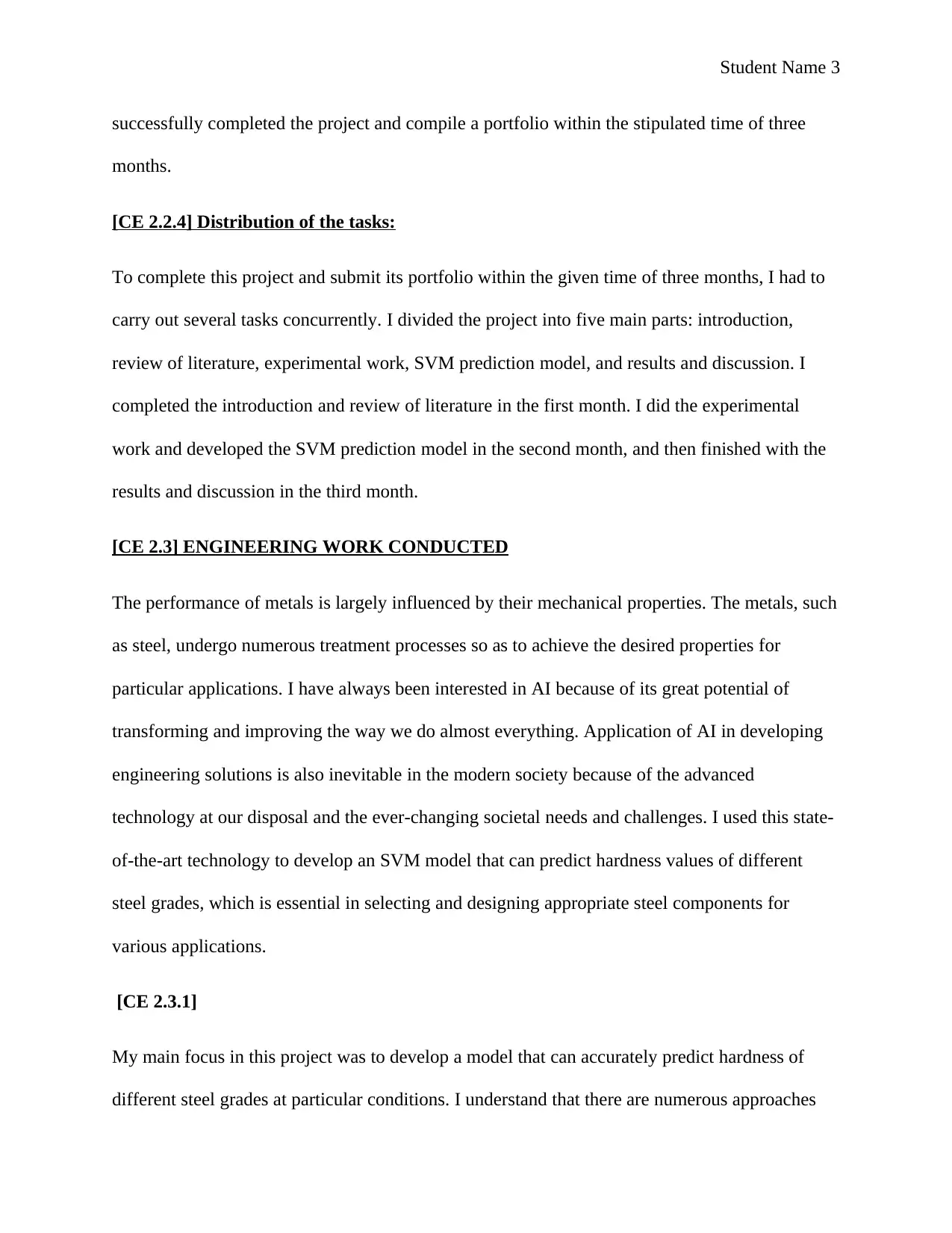
Student Name 3
successfully completed the project and compile a portfolio within the stipulated time of three
months.
[CE 2.2.4] Distribution of the tasks:
To complete this project and submit its portfolio within the given time of three months, I had to
carry out several tasks concurrently. I divided the project into five main parts: introduction,
review of literature, experimental work, SVM prediction model, and results and discussion. I
completed the introduction and review of literature in the first month. I did the experimental
work and developed the SVM prediction model in the second month, and then finished with the
results and discussion in the third month.
[CE 2.3] ENGINEERING WORK CONDUCTED
The performance of metals is largely influenced by their mechanical properties. The metals, such
as steel, undergo numerous treatment processes so as to achieve the desired properties for
particular applications. I have always been interested in AI because of its great potential of
transforming and improving the way we do almost everything. Application of AI in developing
engineering solutions is also inevitable in the modern society because of the advanced
technology at our disposal and the ever-changing societal needs and challenges. I used this state-
of-the-art technology to develop an SVM model that can predict hardness values of different
steel grades, which is essential in selecting and designing appropriate steel components for
various applications.
[CE 2.3.1]
My main focus in this project was to develop a model that can accurately predict hardness of
different steel grades at particular conditions. I understand that there are numerous approaches
successfully completed the project and compile a portfolio within the stipulated time of three
months.
[CE 2.2.4] Distribution of the tasks:
To complete this project and submit its portfolio within the given time of three months, I had to
carry out several tasks concurrently. I divided the project into five main parts: introduction,
review of literature, experimental work, SVM prediction model, and results and discussion. I
completed the introduction and review of literature in the first month. I did the experimental
work and developed the SVM prediction model in the second month, and then finished with the
results and discussion in the third month.
[CE 2.3] ENGINEERING WORK CONDUCTED
The performance of metals is largely influenced by their mechanical properties. The metals, such
as steel, undergo numerous treatment processes so as to achieve the desired properties for
particular applications. I have always been interested in AI because of its great potential of
transforming and improving the way we do almost everything. Application of AI in developing
engineering solutions is also inevitable in the modern society because of the advanced
technology at our disposal and the ever-changing societal needs and challenges. I used this state-
of-the-art technology to develop an SVM model that can predict hardness values of different
steel grades, which is essential in selecting and designing appropriate steel components for
various applications.
[CE 2.3.1]
My main focus in this project was to develop a model that can accurately predict hardness of
different steel grades at particular conditions. I understand that there are numerous approaches
⊘ This is a preview!⊘
Do you want full access?
Subscribe today to unlock all pages.

Trusted by 1+ million students worldwide
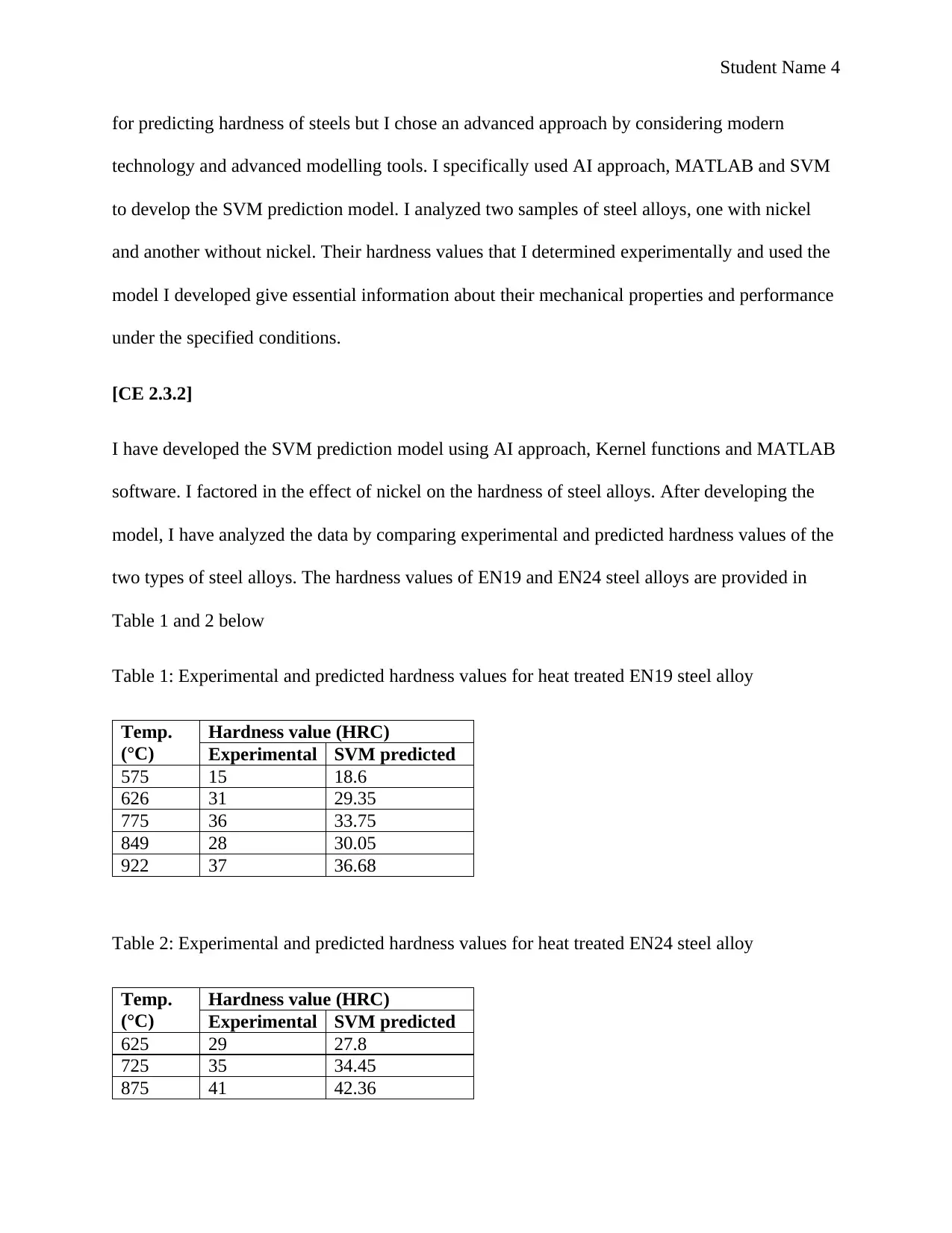
Student Name 4
for predicting hardness of steels but I chose an advanced approach by considering modern
technology and advanced modelling tools. I specifically used AI approach, MATLAB and SVM
to develop the SVM prediction model. I analyzed two samples of steel alloys, one with nickel
and another without nickel. Their hardness values that I determined experimentally and used the
model I developed give essential information about their mechanical properties and performance
under the specified conditions.
[CE 2.3.2]
I have developed the SVM prediction model using AI approach, Kernel functions and MATLAB
software. I factored in the effect of nickel on the hardness of steel alloys. After developing the
model, I have analyzed the data by comparing experimental and predicted hardness values of the
two types of steel alloys. The hardness values of EN19 and EN24 steel alloys are provided in
Table 1 and 2 below
Table 1: Experimental and predicted hardness values for heat treated EN19 steel alloy
Temp.
(°C)
Hardness value (HRC)
Experimental SVM predicted
575 15 18.6
626 31 29.35
775 36 33.75
849 28 30.05
922 37 36.68
Table 2: Experimental and predicted hardness values for heat treated EN24 steel alloy
Temp.
(°C)
Hardness value (HRC)
Experimental SVM predicted
625 29 27.8
725 35 34.45
875 41 42.36
for predicting hardness of steels but I chose an advanced approach by considering modern
technology and advanced modelling tools. I specifically used AI approach, MATLAB and SVM
to develop the SVM prediction model. I analyzed two samples of steel alloys, one with nickel
and another without nickel. Their hardness values that I determined experimentally and used the
model I developed give essential information about their mechanical properties and performance
under the specified conditions.
[CE 2.3.2]
I have developed the SVM prediction model using AI approach, Kernel functions and MATLAB
software. I factored in the effect of nickel on the hardness of steel alloys. After developing the
model, I have analyzed the data by comparing experimental and predicted hardness values of the
two types of steel alloys. The hardness values of EN19 and EN24 steel alloys are provided in
Table 1 and 2 below
Table 1: Experimental and predicted hardness values for heat treated EN19 steel alloy
Temp.
(°C)
Hardness value (HRC)
Experimental SVM predicted
575 15 18.6
626 31 29.35
775 36 33.75
849 28 30.05
922 37 36.68
Table 2: Experimental and predicted hardness values for heat treated EN24 steel alloy
Temp.
(°C)
Hardness value (HRC)
Experimental SVM predicted
625 29 27.8
725 35 34.45
875 41 42.36
Paraphrase This Document
Need a fresh take? Get an instant paraphrase of this document with our AI Paraphraser
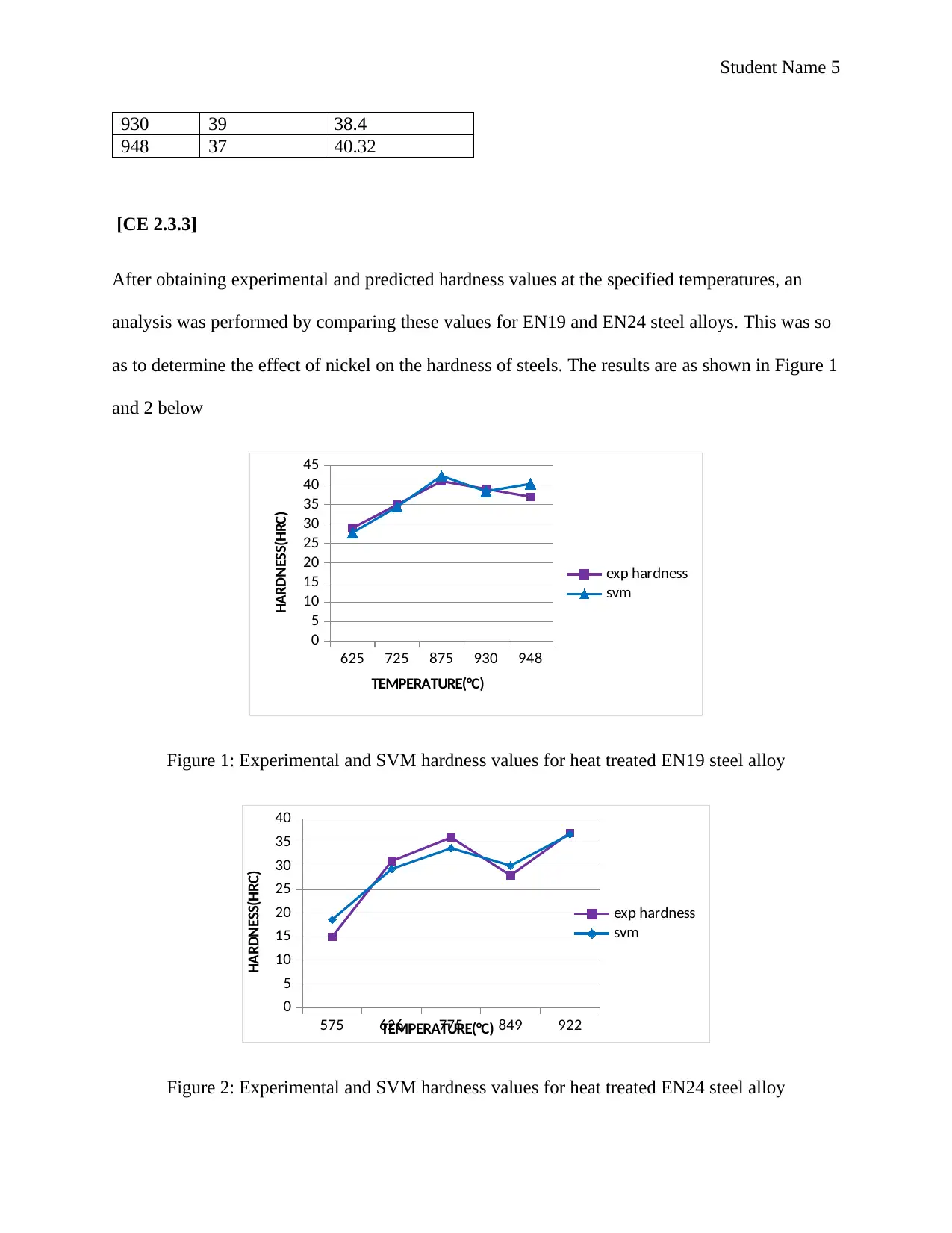
Student Name 5
930 39 38.4
948 37 40.32
[CE 2.3.3]
After obtaining experimental and predicted hardness values at the specified temperatures, an
analysis was performed by comparing these values for EN19 and EN24 steel alloys. This was so
as to determine the effect of nickel on the hardness of steels. The results are as shown in Figure 1
and 2 below
625 725 875 930 948
0
5
10
15
20
25
30
35
40
45
exp hardness
svm
TEMPERATURE(°C)
HARDNESS(HRC)
Figure 1: Experimental and SVM hardness values for heat treated EN19 steel alloy
575 626 775 849 922
0
5
10
15
20
25
30
35
40
exp hardness
svm
TEMPERATURE(°C)
HARDNESS(HRC)
Figure 2: Experimental and SVM hardness values for heat treated EN24 steel alloy
930 39 38.4
948 37 40.32
[CE 2.3.3]
After obtaining experimental and predicted hardness values at the specified temperatures, an
analysis was performed by comparing these values for EN19 and EN24 steel alloys. This was so
as to determine the effect of nickel on the hardness of steels. The results are as shown in Figure 1
and 2 below
625 725 875 930 948
0
5
10
15
20
25
30
35
40
45
exp hardness
svm
TEMPERATURE(°C)
HARDNESS(HRC)
Figure 1: Experimental and SVM hardness values for heat treated EN19 steel alloy
575 626 775 849 922
0
5
10
15
20
25
30
35
40
exp hardness
svm
TEMPERATURE(°C)
HARDNESS(HRC)
Figure 2: Experimental and SVM hardness values for heat treated EN24 steel alloy
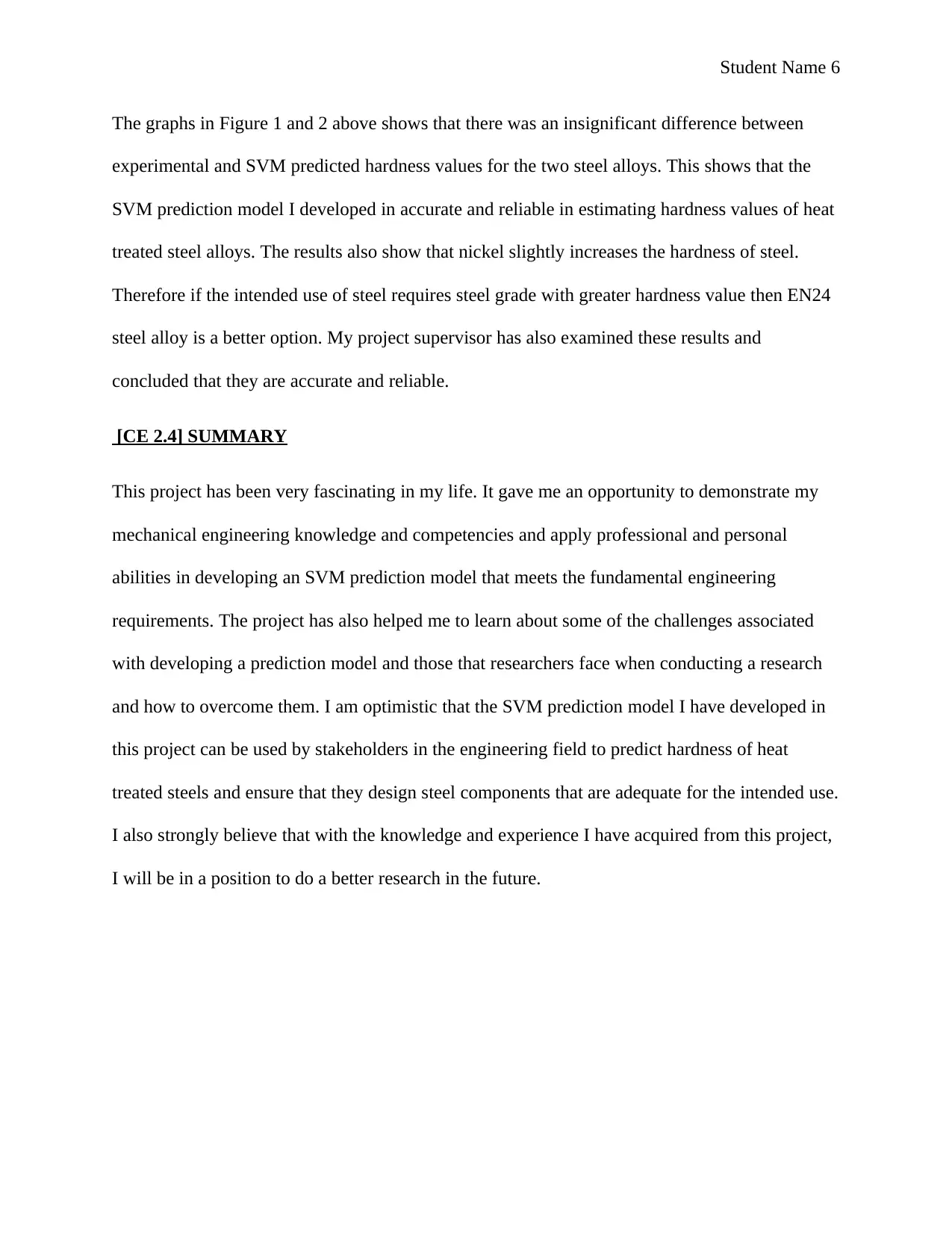
Student Name 6
The graphs in Figure 1 and 2 above shows that there was an insignificant difference between
experimental and SVM predicted hardness values for the two steel alloys. This shows that the
SVM prediction model I developed in accurate and reliable in estimating hardness values of heat
treated steel alloys. The results also show that nickel slightly increases the hardness of steel.
Therefore if the intended use of steel requires steel grade with greater hardness value then EN24
steel alloy is a better option. My project supervisor has also examined these results and
concluded that they are accurate and reliable.
[CE 2.4] SUMMARY
This project has been very fascinating in my life. It gave me an opportunity to demonstrate my
mechanical engineering knowledge and competencies and apply professional and personal
abilities in developing an SVM prediction model that meets the fundamental engineering
requirements. The project has also helped me to learn about some of the challenges associated
with developing a prediction model and those that researchers face when conducting a research
and how to overcome them. I am optimistic that the SVM prediction model I have developed in
this project can be used by stakeholders in the engineering field to predict hardness of heat
treated steels and ensure that they design steel components that are adequate for the intended use.
I also strongly believe that with the knowledge and experience I have acquired from this project,
I will be in a position to do a better research in the future.
The graphs in Figure 1 and 2 above shows that there was an insignificant difference between
experimental and SVM predicted hardness values for the two steel alloys. This shows that the
SVM prediction model I developed in accurate and reliable in estimating hardness values of heat
treated steel alloys. The results also show that nickel slightly increases the hardness of steel.
Therefore if the intended use of steel requires steel grade with greater hardness value then EN24
steel alloy is a better option. My project supervisor has also examined these results and
concluded that they are accurate and reliable.
[CE 2.4] SUMMARY
This project has been very fascinating in my life. It gave me an opportunity to demonstrate my
mechanical engineering knowledge and competencies and apply professional and personal
abilities in developing an SVM prediction model that meets the fundamental engineering
requirements. The project has also helped me to learn about some of the challenges associated
with developing a prediction model and those that researchers face when conducting a research
and how to overcome them. I am optimistic that the SVM prediction model I have developed in
this project can be used by stakeholders in the engineering field to predict hardness of heat
treated steels and ensure that they design steel components that are adequate for the intended use.
I also strongly believe that with the knowledge and experience I have acquired from this project,
I will be in a position to do a better research in the future.
⊘ This is a preview!⊘
Do you want full access?
Subscribe today to unlock all pages.

Trusted by 1+ million students worldwide
1 out of 6
Your All-in-One AI-Powered Toolkit for Academic Success.
+13062052269
info@desklib.com
Available 24*7 on WhatsApp / Email
![[object Object]](/_next/static/media/star-bottom.7253800d.svg)
Unlock your academic potential
Copyright © 2020–2025 A2Z Services. All Rights Reserved. Developed and managed by ZUCOL.

